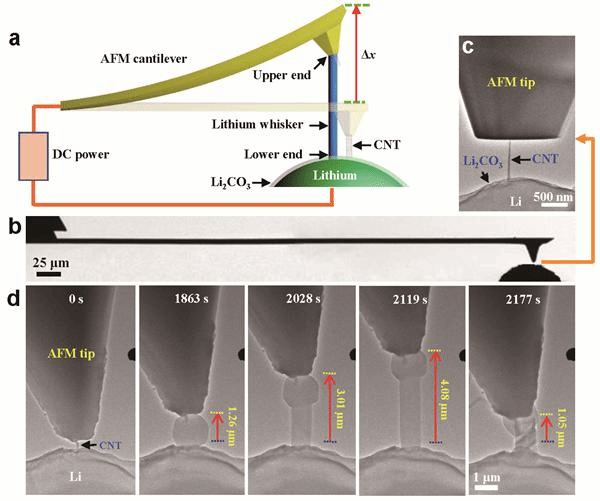[News from the News Center] Recently, Professor Huang Jianyu and Professor Shen Tongde of theState Key Laboratory of Meta-stable Materials Science and Technologyof our university cooperating with domestic and foreign scientists got an article titled “Lithium whiskers growth and stress generation in an in situ atomic force microscope-environmental transmission electron microscope setup” published in Nature Nanotechnology (source link:https://www.nature.com/articles/s41565-019-0604-x). The results recorded the micro-mechanism of the growth of lithium dendrite in a real-time and intuitive way, accurately measured its mechanical properties and force-electrical coupling characteristics, and proposed a feasible solution to suppress lithium dendrite growth in solid-state batteries.
Lithium ion secondary batteries have been widely used in the field of portable electronic equipment due to their high energy density, but they still cannot meet the demand for high energy density of large-capacity energy storage devices such as electric vehicles and power grids. Metal lithium has high specific capacity (3860 mAh g‒1) and low electrochemical potential (‒3.04 V vs. standard hydrogen electrode), making it an ideal high energy density anode material.
The solid state battery with metal lithium as the negative electrode is considered to be the future development direction of high energy density and high safety rechargeable energy storage devices. However, the development of lithium metal batteries is very challenging. Although it has taken many years, high-energy-density rechargeable batteries with metal lithium as the negative electrode have not yet been commercialized.
The main reason is the uncontrollable lithium dendrite (a kind of Dendritic crystals, whose needle-like protrusions are called whiskers). When the lithium dendrite grows to a certain extent, it can penetrate the solid electrolyte and make the battery short-circuit failure. In addition, if the lithium dendrite is entangled or broken, it will form “Dead Lithium” causes severe deterioration of battery capacity, so the growth of lithium dendrites is the biggest obstacle hindering the application of metal lithium batteries.
Many studies have been devoted to exploring how to suppress the generation of lithium dendrites, but the previous research has mainly focused on the macroscopic scale. The microscopic mechanism of lithium dendrite growth, mechanical properties, the mechanism of piercing solid electrolytes, and the scientific basis for inhibiting its growth are unclear.

AFM-ETEM nano-electrochemical test platform can realizethein-situ observation of lithium dendrite growth mechanism in nano-solid-state batteries, and accurate quantitative measurement of its mechanical properties and force-electric coupling.
Researchers have combined atomic force microscopy (AFM) and environmental transmission electron microscopy (ETEM) to achieve the accurate measurement of in-situ nano-scale lithium dendrite growth, its mechanical properties, and force-electric coupling. It is found that the stress that can be generated during the growth of lithium dendrites is as high as 130 MPa. Through in-situ compression experiments, it is found that the yield strength of lithium dendrites is as high as 244 MPa, which is much higher than the yield strength of macro-metal lithium (~ 1 MPa).
The innovations of this paper are: (1) An in-situ electrochemical test platform based on atomic force microscope-environmental transmission electron microscope (AFM-ETEM) was invented. On the one hand, AFM is used as an electrode for growing lithium dendrites, and on the other hand, it generates a binding force during the growth of lithium dendrites, and it can also monitor the growth stress in real time. The platform can be widely used to study the mechanics of dendrite growth and the force-electric coupling problems in sodium, potassium, magnesium, calcium and other battery systems. (2) A new technology of studying the dynamic in-situ experimental characterization of lithium dendrites has been established, and the mechanical properties of micro-nanoscale lithium dendrites under electrochemical and non-electrochemical driving have been determined. Based on the structural defect, the mechanical properties of the electrolyte, and the adaptability of the lithium dendrite's mechanical properties, a feasible solution to suppress the growth of lithium dendrites was proposed. (3) By using the ETEM technology properly and injecting CO2 into the ETEM, a nanoscale Li2CO3 solid electrolyte (SEI) protective layer is grown in situ on the Li metal surface. It is this ultra-thin Li2CO3 SEI protective layer that significantly improves the stability of ultra-active lithium metal in TEM, and prevents it from being damaged by electron beams, thereby achieving the in-situ imaging of submicron lithium dendrite growth process at room temperature, and the measurements of the mechanical properties and force-electric coupling.
This research subverts the researchers' traditional knowledge of the mechanical properties of lithium dendrites, provides a new quantitative benchmark for inhibiting the growth of lithium dendrites in all-solid-state batteries, and provides a scientific basis for the design of metal lithium solid-state batteries with high capacity and long life. The research results will help the application of solid-state batteries in electric vehicles, large-scale energy storage and portable electronic devices.
Dr. Zhang Liqiang and doctoral student Yang Tingting are co-first authors, and YSU is the first authors’ affiliation. This research project was supported by theNSFCand the Ministry of Science and Technology.
[Translated by Yu Miao]